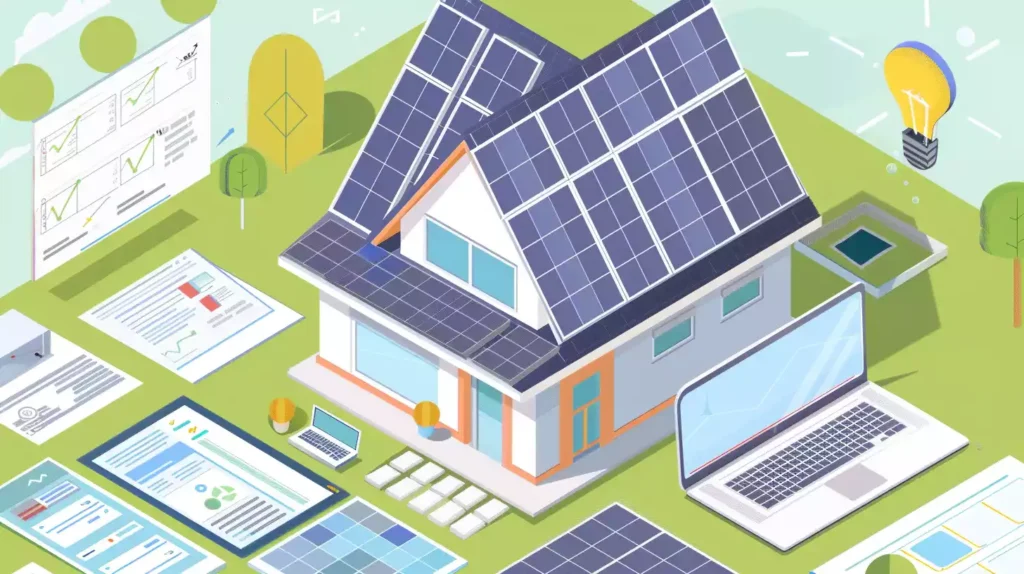Why Are Solar Panels So Expensive? Understanding the Costs
Solar panels are costly because of raw material expenses, advanced technology needs, and labor costs. The materials, like silicon and aluminum, play a substantial role.
Skilled labor and tech increase production costs. Installation factors in labor, permits, and equipment. Incentives and rebates exist to offset these costs. A breakdown shows panels, inverters, labor, and other components account for expenses.
High labor rates, market conditions, and soft costs make them expensive. Quality installation is crucial for efficiency. Reputable installers guarantee durability. Market conditions, tax credits, and technological advancements influence prices.
Quick Summary
- Raw materials like silicon and labor costs contribute significantly to solar panel expenses.
- Advanced technology and skilled labor increase production costs.
- Soft costs, including labor and permitting, constitute a significant portion of total expenses.
- Market conditions, such as global demand and supply chain disruptions, impact pricing.
- Tax credits and incentives play a crucial role in reducing the overall cost for consumers.

Factors Influencing Solar Panel Costs
When considering the factors influencing solar panel costs, raw materials such as silicon, copper, and aluminum greatly contribute to the overall expense.
The process of extracting these materials and turning them into efficient solar cells involves advanced technology and skilled labor, which adds to the production costs. Furthermore, installation costs play a significant role in the total expense of solar panels.
Factors like labor, permits, and equipment needed for proper installation can bump up the overall price tag.
However, it’s not all doom and gloom when it comes to solar panel costs. Incentives and rebates provided by governments and energy companies can help offset some of the high initial investments.
These financial incentives aim to encourage more people to adopt solar energy, making it a more affordable and attractive option for homeowners and businesses alike.
Equipment Costs Breakdown
Breaking down the costs of solar equipment reveals essential insights into the financial aspects of installing a solar energy system.
When considering the expenses involved, it’s important to note that solar panels typically account for around 12% of the total cost, while inverters make up approximately 10%.
These components, along with other hard costs like racking, mounting equipment, and wiring, play a significant role in the overall expenditure.
Soft costs, on the other hand, which encompass items such as labor, permitting, marketing, and overhead, make up a substantial 56% of the total solar system cost. Understanding this breakdown can shed light on why solar panels are relatively expensive.
Below is a breakdown of the costs associated with solar equipment:
| Category | Cost Percentage |
|---|---|
| Solar panels | 12% |
| Inverter costs | 10% |
| Soft costs | 56% |
| Additional components | Remaining 22% |
Impact of Labor Rates
Labor rates play an important role in determining the overall cost of solar panel installations. The availability of skilled workers and disparities in wages between regions can greatly impact the final price.
We suggest always comparing labor rates from different installers to find a competitive option that fits your budget.
Labor Costs Influence
Considering the significant role labor costs play in the total expense of solar panel installations, it becomes essential to understand how varying labor rates across regions impact the overall affordability of solar energy systems.
Labor costs directly impact the total cost of solar panel projects, as higher labor rates in specific areas can drive up the overall expenses.
Skilled labor for installation, permits, inspections, and related tasks are pivotal components that contribute to the final price of solar panel installations. Variations in labor costs across different locations influence the overall cost of solar panel systems, making it important to factor in these expenses when considering the affordability of solar energy.
Labor expenses are a key factor in determining the feasibility and cost-effectiveness of implementing solar panel solutions.
Skilled Workforce Availability
Skilled workforce availability directly influences the labor rates for solar panel installations, impacting the overall cost of implementing solar energy systems. The availability of trained professionals in the field of solar panel installations plays an important role in determining labor costs.
Areas with a high concentration of skilled workers may experience lower labor rates due to competition, while regions facing a shortage of trained workforce often see higher labor costs. This disparIty in labor rates can contribute greatly to the overall expense of solar projects.
Ensuring a steady supply of qualified and experienced individuals for solar panel installations is essential for managing labor costs effectively. By addressing the issue of skilled workforce availability, we can work towards making solar energy systems more cost-efficient and accessible to a wider audience.
Wage Disparity Effects
Understanding the economic implications of wage disparitites plays an essential role in analyzing the impact of labor rates on solar panel installation costs. Labor rates have a substantial influence on the overall expenses of solar panel installations, with costs varying by region.
In areas where labor rates are higher, the installation expenses tend to increase, making solar panels more costly. While skilled labor is vital for proper installation, higher wages can lead to inflated project costs.
The disparities in wages across different regions can result in notable differences in the overall cost of solar panel installations.
It’s imperative to grasp how labor rates affect solar panel prices to effectively budget and plan solar projects.
Soft Costs Overview
Soft costs play a significant role in the overall expense of solar panel installations, accounting for a substantial portion of the total cost. Expenses such as labor, permitting, and marketing contribute to these soft costs, adding to the financial burden of going solar.

Installation Labor Expenses
Labor expenses play a significant role in the total cost of solar panel installations, accounting for 56% of the overall expenses. These installation labor expenses are a key component of the soft costs that contribute to the high price of solar panel systems.
Besides the physical installation labor, soft costs encompass various other expenses such as permitting, inspections, marketing, utility fees, sales commissions, and profit margins.
The significant portion of soft costs attributed to labor costs highlights the importance of efficient processes and streamlined operations to reduce overall expenses.
Permitting and Inspection Fees
Allowing and inspection fees greatly impact the total cost of solar panel installations, emphasizing the importance of budgeting for these soft costs.
These permitting and inspection fees, categorized under soft costs, cover the expenses involved in obtaining approvals and ensuring compliance with building codes and safety regulations. They’re vital for guaranteeing the quality and safety of the solar panel system.
Keep in mind that these fees can vary depending on your location, adding to the overall expense of going solar.
Marketing and Advertising Costs
To effectively promote the adoption of solar energy, marketing, and advertising costs play a pivotal role in the overall expenses of solar panel installations.
- Soft costs, encompassing marketing and advertising expenses, constitute a substantial 56% of the total cost of solar panel installations.
- These expenses cover various aspects such as labor, permitting, marketing, overhead costs, and other non-hardware related expenditures.
- While marketing and advertising efforts are essential for driving the adoption of solar energy, they can also contribute to the total cost of installations.
Strategies aimed at reducing soft costs can be instrumental in making solar panels more cost-effective and accessible to a broader spectrum of consumers.
Quality Installation Importance
Ensuring quality installation of solar panels is vital for maximizing efficiency and system longevity. Proper solar panel installation not only guarantees peak performance but also helps prevent potential system failures down the line.
A high-quality installation is essential for maximizing energy production and ensuring a strong return on investment throughout the system’s lifespan.
On the flip side, incorrect installation can lead to reduced efficiency, void warranties, and result in costly repairs or replacements.
Investing in a reputable and experienced installer is essential to the effectiveness and durability of your solar panel system. These professionals have the expertise to handle the intricacies of installation, ensuring everything is set up correctly from the start.
By prioritizing quality installation, you set the foundation for a reliable and efficient solar panel system that will serve you well for years to come.
Market Conditions Effect
Amidst the dynamic landscape of market conditions, the pricing of solar panels can be substantially influenced by various factors.
- Fluctuations in raw material prices, such as silicon, copper, and aluminum, directly impact solar panel costs. These variations can greatly affect the overall expenses involved in producing solar panels.
- Global demand for solar panels plays an essential role in determining their prices. As the demand for renewable energy sources increases worldwide, the competition for solar panels rises, potentially leading to higher prices.
- Supply chain disruptions and other market conditions can also contribute to fluctuations in solar panel costs. Issues like tariffs on imported solar panels or limited availability of skilled labor can further impact the final pricing for consumers.
These market dynamics illustrate the intricate interplay of various factors influencing the affordability of solar panels. By understanding these elements, consumers can gain insights into why solar panels are priced the way they’re in today’s market.
Tax Credit Influence
Considering the impact of tax credits and incentives on solar panel affordability, it becomes evident that these financial benefits play a significant role in reducing overall expenses for consumers. The federal investment tax credit (ITC) offers a substantial 26% reduction in solar system costs for homeowners, making going solar more financially feasible.
However, it’s important to note that the ITC is set to decrease to 22% in 2023, affecting the total expense of solar panel installations. Additionally, various states and local utilities provide extra rebates and incentives, further lowering the upfront costs of solar panels.
By subtracting these total incentives from the system price, consumers can determine the actual out-of-pocket expense, helping them assess the financial viability of investing in solar energy.
Understanding how tax credits and local incentives impact the affordability of solar panels is essential for individuals looking to make environmentally friendly and cost-effective choices for their homes.
Technological Advancements Impact
Innovative technological progress in solar panel efficiency has greatly impacted the affordability and effectiveness of solar energy systems.
The continuous advancements in solar technology have revolutionized the industry, making solar panels more accessible and cost-effective for consumers and businesses alike.
Here are three key ways these technological advancements have influenced the solar market:
- Enhanced energy output: Technological innovations have remarkably increased the energy output of solar panels, reducing the overall cost per kilowatt-hour generated.
- Improved storage solutions: The development of advanced storage solutions has enhanced the performance and reliability of solar energy systems, contributing to their cost-effectiveness.
- Smart technology integration: The incorporation of smart technologies for monitoring and control has streamlined the management of solar panel systems, improving efficiency and reducing overall costs.
These advancements not only make solar energy more sustainable but also make it a more viable option for a wider range of applications, driving the growth of the solar industry.
Total Cost Calculation Factors
One crucial aspect to comprehend when assessing the cost of solar panels is the breakdown of various factors contributing to the total expense.
Solar panel costs encompass not only raw materials like silicon, copper, and aluminum but also research and development expenses. Moreover, installation costs, which include labor, permits, and equipment, play a significant role in the overall price of solar panels. Incentives and rebates can help offset these costs for homeowners, making solar energy more accessible and affordable.
It’s important to take into account the dynamic nature of market demand and supply when analyzing solar panel pricing.
By understanding the breakdown of total costs, including equipment, labor, and potential incentives, we can grasp why solar panels may seem expensive upfront but can provide long-term savings and environmental benefits.
These factors all contribute to the final price tag attached to solar panels, highlighting the multifaceted nature of calculating their total cost.
